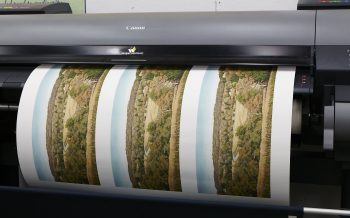When it comes to choosing the right inkjet paper for digitally printed reproductions of your artwork, it ultimately comes down to personal preference. However, some papers naturally work better for certain art forms, and choosing the paper you print on can be as much of an art as it is a science. Here are some tips to pick the paper that will work best for you:
The first determining factor is the type of printer you’re using, since not all printers are compatible with all papers. The preferred print technology for most fine art printers is aqueous, which has the most compatible papers on the market, and newer models, like Epson P-Series and Canon PRO-Series printers, have 10- and 12-ink options for greater color gamuts that are truer to the original art.
 Some printers are moving to eco-solvent technology, like Sacramento Giclee, which recently added a Epson SureColor S80600 to its operation. The solvent technology eliminates the need to coat the print, which is helpful for busy, large-volume shops.
Some printers are moving to eco-solvent technology, like Sacramento Giclee, which recently added a Epson SureColor S80600 to its operation. The solvent technology eliminates the need to coat the print, which is helpful for busy, large-volume shops.
Once you’ve narrowed down your printer compatibility, think about your preferences in the following characteristics and how they perform for different types of artwork:
Paper weight: Fine art papers will very grams per square meter, and lighter-weight options run in the 200 range, such as Sunset Etching SD Paper 210g; while heavier versions are above 300 gsm, like the Sunset Copperplate Rag 315gsm. The heavier options tend to lay flat more and make for an impressive presentation if you’re handing the print to someone, rather than presenting it in a frame.
Paper base and coating: The most luxurious paper base will be cotton, sometimes referred to as “rag.” These are typically more expensive and offer more longevity, such as Sunset Velvet Rag 315g, which meets the highest printing standards for museum-quality reproduction. Alpha-cellulous options are easier to make and are less expensive, such as Sunset Cotton Etching Paper 285g, which is 75% alpha cellulous and 25% cotton. These papers can have microporous coatings that dry quickly and offer more of an art hand feel, or resin coating that’s more of a photo paper smooth texture that benefits from a high dmax, which will be important for black-and-white artwork or photography.
Texture: Here’s where personal preference really comes into play. Do you like a smooth finish for your art, or a heavy texture? The more texture a paper has, the more painterly feel the paper will offer. A canvas like Sunset by Fredrix Matte Canvas is a great medium-texture example that feels almost like fabric and also meets Wilhelm Archival Quality Standards to last up to and beyond 200 years. A baryta paper is a preferred option for artists who work in black-and-white and demand extreme detail, thanks to it’s ultra-smooth, texture-free surface, like you’ll find with Sunset Fibre Baryta 310gsm.
Finish: Your preference will definitely come into play with a paper’s finish, but some finishes do work better on particular artwork types. For instance, a matte finish will enhance that painterly look and reproduce less glare while adding to the texture, making it a good option for painting reproductions. However, matte finishes tend to have a lower dmax, so blacks may not be as strong. A semi-gloss sheen is often preferred for graphic reproductions, while gloss will create super-high contrast with lots of reflection. Gloss is the least forgiving in terms of image problems like dust or low-resolution, but a favorite for photo reproduction. When it comes to finish, print out your piece on papers with different finishes and ask for feedback. You might be surprised how much people prefer one print over another.
To give you a chance to try out papers, many brands provide sample packs, such as the LexJet Sunset Media Portfolio Pack, Epson Legacy Sample Pack, and Epson Signature Sample Pack. Try printing the same image on the different papers to see how they produce your art.
Still can’t decide? Call a LexJet fine art paper specialist at 800-453-9538.

